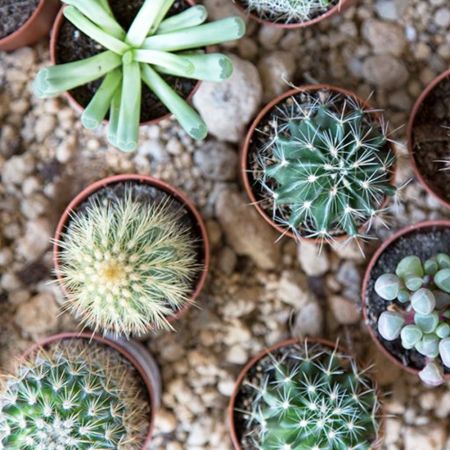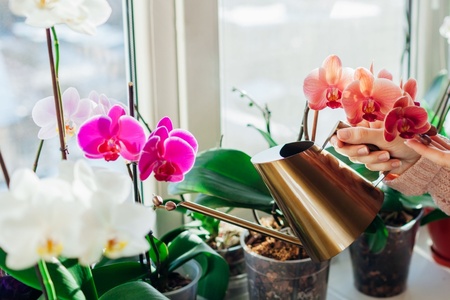
The leaves have turned and the nights are drawing in: the colder season is well and truly upon us. Our gardens are looking a little less full and the temperature is beginning to dip into single digits. However, just because the winter months are ahead and frosts threaten, there's no reason to hang up the gardening gloves until spring.
Soldiering on through the lack of light and warmth, winter houseplants bring nature inside during months when spending too much time outdoors becomes less and less tempting. Create an oasis of leaves, flowers and prickly perennials with our guide to caring for houseplants, including a few of our favourites for inspiration. We have a wide selection of indoor plants in store just waiting to brighten up your home this winter; house plants also make for brilliant gifts for family and friends in the run up to Christmas, with a number of spring bulbs able to be persuaded to flower early in the right conditions. Our garden experts will be happy to point you in the right direction and offer care tips to ensure a colourful display throughout the cooler months and beyond.
5 Houseplants to Grow over Winter
Peace Lily
A beautiful flowering house plant, Peace Lilies (or Spathiphyllum wallisii) are very easy to care for and, thanks to their larger size, make a lovely feature plant in the home. As well as being visually stunning, with their white flowers and vibrant green leaves, Peace Lilies also have a brilliant practical use: they make for excellent air purifiers. This is thanks to the ability of this multi-tasking house plant to remove toxins such as ammonia and Trichloroethylene (which is often given off by furniture) from the air. Peace Lilies will do best in light shade, away from drafts; come winter, they need relatively little water, however mustn't be allowed to dehydrate.
Azaleas
Indoor Azaleas will grow best in cool, humid conditions; the plant will want to stay away from direct sunlight and drafts, however still be placed in a well-lit area (near a bright window or in a porch, for example). Thanks to their need to stay well-watered, Azaleas will benefit from the odd 'dunking': submerge your Azalea pot in water, lifting it out and draining once the bubbles disappear.
A tray of wet pebbles makes for a good base on which to place your Azalea to improve humidity; too long in dry conditions, and leaves will begin to brown and drop.
Hyacinths
Typically a spring flowering bulb, hyacinths can be persuaded to flower in the run-up to Christmas when grown indoors, which will ensure a thoughtful, colourful gift with visual impact. How long the bulb will take to flower depends on the type of hyacinth, however no matter which you go for, make sure to purchase 'prepared' bulbs as these are made to bloom before Christmas. If you're planning to give the gift of a hyacinth this festive season, bulbs should be planted between September – October. Alternatively, we have ready grown hyacinths in store throughout December: pop in and ask one of our garden experts on the shop floor, as they'll be happy to help.
Cacti + Succulents
A low maintenance houseplant, cacti and succulents make for a fresh, modern display which brings a little easy greenery indoors throughout the year. However, contrary to popular belief, cacti are not invincible and do require specialised care (albeit at a minimum!).
Their ability to store water in their leaves or stems means little to no watering is required over winter while they rest; however, they will need a little hydration whenever their soil dries out completely to keep them healthy. This is especially apt if you plan to place your cacti or succulents near to a radiator: they should be fine, but will need occasional watering.
Poinsettia
A colourful festive flower, Poinsettias require minimum temperatures of 13 – 15 degrees and access to a filtered light source. Their bright, red petals and colourful appearance make them a popular plant come Christmas; misting Poinsettias will ensure a longer flowering period. However, over watering is a hazard when it comes to these vibrant flowers, so be sure to water only when the compost looks dry.
Keep Poinsettias away from drafty areas and cold windowpanes; maintaining a constant temperature and keeping your Poinsettia humid (placing the plant on a wet pebble tray can work well to improve conditions) will help to ensure a longer life.
General Care Advice
While all houseplants have their own unique requirements, there are a few tips and tricks which can often be universally applied.
Water houseplants with rainwater
Make use of the abundant rainwater we often see in the UK (particularly here in the north west!) and gather some to water your houseplants. They'll thank you for it, as tap water can cause mineral deposits.
Allow plants to rest
Winter is a time for houseplants to take a break, ready to begin growing again in spring. While there are plenty of houseplants which will still look beautiful in the winter months, it's most commonly a time to ease off on watering and feeding houseplants, allowing them a break while they're dormant.
Don't over water
When plants live indoors, it can be tempting to overcompensate for the lack of rain by watering regularly - but this can sometimes do more harm than good. Plants shouldn't be sitting in a pool of water, and in the winter months, watering should be kept to a minimum.
Keep leaves dust free
Houseplants have a tendency to gather dust on their leaves, meaning less light can reach them and as a result, plants will have a hard time photosynthesizing to produce food. Cleaning houseplants on a regular basis is a good way to make sure this doesn't happen. Use lukewarm water to gently shower or hose down house plants; or take a damp cloth and clean individual leaves.
Maintain a consistent temperature
As a general rule, houseplants don't like sudden, regular or significant differences in temperature. This is something to pay extra attention to in winter, when central heating can cause temperatures at home to rise and fall; keeping houseplants somewhere with a consistent temperature and away from drafts can help to combat brown leaves and wilting.
Keep humidity levels in mind
Some houseplants enjoy humid conditions, and will benefit from sitting on a tray of wet pebbles to improve access to moisture (these include poinsettias and azaleas). Keep the level of humidity in your home in mind, particularly during winter months when dry air is more prevalent.
Have you created a stunning houseplant display? We'd love to see it! Share your photos with us on Facebook, Twitter or Instagram.



